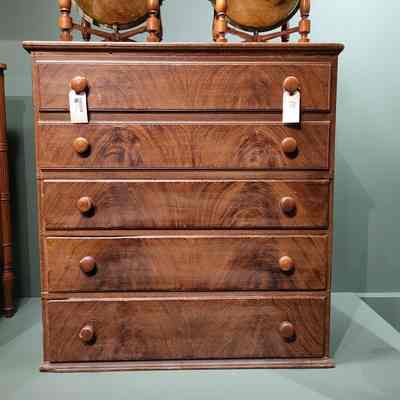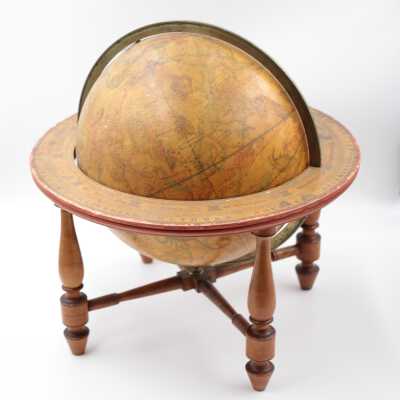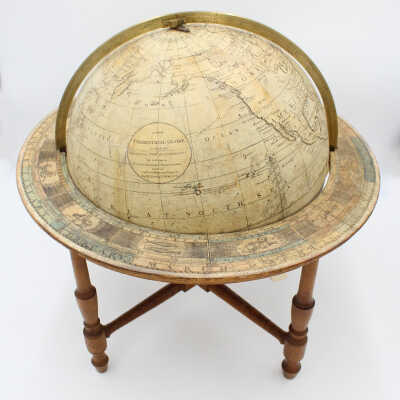113/8


Blanket Chest
Name/Title
Blanket Chest
Lexicon
Description
Grain painted, three-drawer blanket chest. Appears to have five drawers, the top two are false and disguise a lift-top chest. Appears to be of mostly pine with joined construction. Drawer rails are nailed, but may have been added later. The chest shows evidence of bracket feet, now missing. The drawer fronts and sides are grain-painted to look like book-matched veneer. The remaining surfaces, save the back, are sponge painted in the same brown and yellow coloration. The drawers all show evidence of two-pin pulls, later replaced with the wooden knobs. Under the lid, there are small areas of surface that have plain red paint. The holes for the original pulls have been filled and the grain painting applied over. It's probable that the piece was originally plain red and later modified with the wooden pulls and elaborate grain painting.
Acquisition
Accession
1988.6
Relationships
Related Person or Organization
Wheelock, Abijah
Person or Organization
Related Places
Place
Calais
Town
Washington County
County
Vermont
State/Province
United States of America
Country
North America
Made/Created
Date made
1760-1780
Dimensions
Dimension Description
Overall dimension
Entry/Object ID
1988.6.1
Context
According to family history, this chest was brought to Calais, Vermont, by Abijah Wheelock in 1789. One of the earliest European families to settle in this area, objects associated with the Wheelocks held a certain colonial allure. It's evident that this chest went through a fair amount of modification. It was probably painted plain red, sported bracket feet, and simple brass pulls. At some time the feet were removed or broke off. The spectacular grain painting was added at a later date, perhaps as early as the 1820s. Vermont had a great tradition of grain painting - transforming plain furniture forms of soft woods into something akin to high style mahogany, curly maple, or figured fruit wood examples from prosperous cities.


Globe
Name/Title
Globe
Lexicon
Description
13" terrestrial globe by James Wilson and Sons, Albany, New York. This globe, made in 1831, is of an edition which represents the highest point in globe making attained by the Wilson family.
Acquisition
Accession
1962.66
Relationships
Related Person or Organization
Wilson, James (1763-1855)
Person or Organization
Made/Created
Date made
1831
Materials
Material
Paper, Wood, Brass
Entry/Object ID
1962.66.1


Globe
Name/Title
Globe
Lexicon
Description
13" celestial globe made in 1831 by James Wilson and Sons, Albany, New York.
Acquisition
Accession
1962.66
Relationships
Related Person or Organization
Wilson, James (1763-1855)
Person or Organization
Made/Created
Date made
1831
Materials
Material
Wood, Brass, Paper
Entry/Object ID
1962.66.2


Globe
Interpretative Labels
Label
Globe, 1810-1819
James Wilson
Bradford, VT
Wood, paper, brass
Anonymous gift, 1921.16
James Wilson of Bradford was raised on a farm and trained briefly as a blacksmith. He moved to Bradford as a young man in 1796 and became interested in cartography. After visiting Dartmouth College's map collection, he grew particularly enamored of globes, and set out to make his own. It took several years of experimentation and learning new skills - he was almost exclusively self-taught - but Wilson began officially manufacturing his globes in 1813. Producing a high-quality globe required mastering a variety of skills - printing, engraving, woodworking, and blacksmithing - all with a high degree of precision.
Wilson manufactured a variety of globes, including a line of papier-mache globes that he could produce and sell inexpensively. His globes were the first to be manufactured in America, and found a ready audience in schools in particular. This globe was not among his first run, but was produced later, in 1816. The Wilson Manufacturing Company continued to produce globes in Vermont and New York for nearly fifty years.
Name/Title
Globe
Lexicon
Description
World globe printed on paper that is glued onto a hollow wooden sphere. The sphere rests in a stand made of wood and brass, and spins freely in two directions. The brass portion encircles the globe vertically, and is marked with measurement hash marks and numbers meant to indicate longitude. The wooden stand encircles the globe horizontally and on its flat surface there are more printed paper designs depicting astrological signs. The horizontal piece also includes measurement hash marks meant to indicate latitude.
The wooden stand is supported on four turned legs that are connected crosswise in the center. The globe can spin freely or be locked in place by making adjustments to the brass piece.
On the legend on the globe is printed the explanatory text: "A NEW / TERRESTRIAL GLOBE, / on which the / TRACTS and NEW DISCOVERIES / are laid down / from the Accurate Observations / made by / Cap.t. Cook, Furneux, Phipps & C. / By J. WILSON, VERMONT."
The wooden stand is supported on four turned legs that are connected crosswise in the center. The globe can spin freely or be locked in place by making adjustments to the brass piece.
On the legend on the globe is printed the explanatory text: "A NEW / TERRESTRIAL GLOBE, / on which the / TRACTS and NEW DISCOVERIES / are laid down / from the Accurate Observations / made by / Cap.t. Cook, Furneux, Phipps & C. / By J. WILSON, VERMONT."
Acquisition
Accession
1921.16
Made/Created
Artist Information
Wilson, James (1763-1855)
Artist
Date made
circa 1810
Manufacturer
Wilson Manufacturing Company
Dimensions
Dimension Description
Overall
Materials
Material
Paper, Wood, Brass
Entry/Object ID
1921.16
Context
Made by Wilson Manufacturing Company in Bradford, VT.
Web Links and URLs


Sideboard
Name/Title
Sideboard
Lexicon
Description
Cherry sideboard. The four corners are reeded columns, and the serpentine front is decorated with intricately banded fruitwood inlays and beaded moldings. The drawer and cabinet pulls are original brass. There are two bottle drawers flanking a central bar cabinet over two wide drawers. The name "Albert Onion" is writted inside the top front copuboard section.
Acquisition
Accession
2001.21
Relationships
Related Publications
The Best the Country Affords
Publication
Made/Created
Date made
circa 1815
Dimensions
Dimension Description
Overall
Materials
Material
Wood, Brass
Entry/Object ID
2001.21.1
Context
Family history states this half-sideboard was made by Albert Onion, of Chester, Vermont in 1840. Though inscribed with his name, the piece dates from earlier in the century, probably constructed around 1815 at the latest. A vibrant cabinetmaking industry existed in the early years of the 19th century in Chester and the nearby town of Windsor, Vermont. The half sideboard form was popular in northern Windsor county.
Cabinetmakers Sampson Warner, George Stedman, and Royal Gould all worked in Chester. It's thought that Stedman and perhaps Gould apprenticed to Warner. Stedman and Gould family members ran a mercantile business in Chester in close proximity to a similar business owned by the Onion family. The string inlay along the top and the complex shape of the front certainly relate to furniture made by both Gould and Stedman. Stedman ultimately moved to Norwich and Gould to Rutland. The Onion family, including Alfred, also moved to the Rutland area and may indicate a connection between the Goulds and the Onions.
This piece may have been purchased by the prosperous Onion family in the 1810s or Albert acquired it around the 1840 date. Albert partnered in mercantile businesses from the late 1820s to 1840 when he was listed in the census as owning a tanning factory.
Cabinetmakers Sampson Warner, George Stedman, and Royal Gould all worked in Chester. It's thought that Stedman and perhaps Gould apprenticed to Warner. Stedman and Gould family members ran a mercantile business in Chester in close proximity to a similar business owned by the Onion family. The string inlay along the top and the complex shape of the front certainly relate to furniture made by both Gould and Stedman. Stedman ultimately moved to Norwich and Gould to Rutland. The Onion family, including Alfred, also moved to the Rutland area and may indicate a connection between the Goulds and the Onions.
This piece may have been purchased by the prosperous Onion family in the 1810s or Albert acquired it around the 1840 date. Albert partnered in mercantile businesses from the late 1820s to 1840 when he was listed in the census as owning a tanning factory.